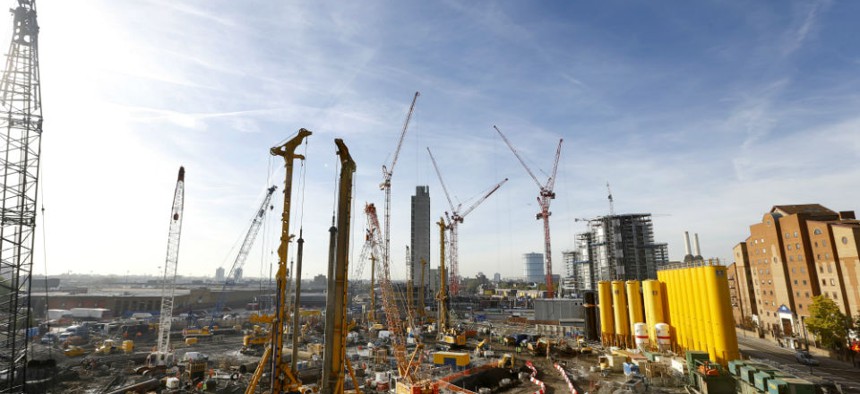
A general view of the construction site where the new U.S. Embassy is being built. Kirsty Wigglesworth/AP
The U.S. Is Building Its New London Embassy on a Stone-Age Campground
The shimmering, bomb-resistant glass structure will be surrounded by a moat.
Four years ago, a Philadelphia architecture firm won the right to design the new United States Embassy building in London.
And in the last year, archaeologists monitoring the construction site have discovered tools, charred remains of campfires, and even animal bones dating back 800,000 years to the Stone Age, LiveScience reports. In other words, our diplomatic mission in London is going to sit on top of a caveman campground.
"Prehistoric sites in London are extremely rare and to have such a vast horizon preserved is quite significant," Kasia Olchowska, a senior archaeologist at the Museum of London Archaeology, tells Megan Gannon.
England's streets have a knack for hiding history for ridiculously long periods of time. In 2012, archaeologists discovered the skeleton of King Richard III, who ruled England during the 15th century, beneath the asphalt of a parking lot.
In 2008, the State Department bought a new site for the U.S. Embassy in the Nine Elms area of Wandsworth in London, on the south side of the Thames River. It then launched a contest to find a design firm to build the diplomatic hub. The embassy's existing location, a 1950s-era structure in central London, was "too small, outdated, and hard to defend from security threats," said Louis Susman, then the U.S. ambassador to Britain.
KieranTimberlake won the competition in February 2010. The embassy, slated for completion in 2017, will be a massive, $1 billion glass cube mounted on a colonnade, with a pond and pathways for the public (see a photo here). Within the beautiful, shimmering design are some pretty intense security measures: The glass exterior is bomb-resistant, and the pond is essentially a moat.
Back when the State Department was considering designs, more than two years before an attack in Benghazi, Libya, would kill four American diplomats and expose preventable security issues, embassy safety was a big concern. The Washington Post's Philip Kennicott wrote in 2010 about the department's competition:
It might … reflect the State Department's desire for fresh and deeper thinking about how to design aesthetically pleasing but secure facilities. In recent years, the government has relied on standard embassy designs as it worked to rapidly replace or upgrade overseas facilities in the nervous post-2001 environment. Many of those were criticized for being fortresslike, forbidding, and isolated from their surroundings and the people they serve.
In a post-Benghazi word, "fortresslike, forbidding, and isolated" probably sounds just about right, even in a much friendlier nation.







